Central America is prone to hurricane disasters
An estimated 185 million residents call the eight countries that make up the region home.
Water from hurricanes, tropical storms kills more in US than wind
Water from hurricanes, tropical storms kills more in US than wind.
Central America faces a hurricane threat from Julia, but if the storm follows precedent, it will be the rainfall, not the winds, that cause widespread destruction throughout the region.
Eight countries make up Central America and many are mountainous with poorly constructed infrastructure.
The combination of the torrential rainfall and the terrain have produced deadly consequences from systems that were merely just a tropical depression or tropical storm.
The more organized cyclones have caused thousands of deaths because communities simply give way or are buried in landslides.
Fortunately, not all of the countries see a yearly threat from tropical cyclones, but some are impacted several times a season by either a close pass or a direct hit.
The 2020 Atlantic hurricane season, which holds the record for having the most named storms, led to several disasters across the region.
During the record-breaking season, tropical cyclones Cristobal, Marco, Nana, Gamma, Delta, Zeta, Eta and Iota all produced significant impacts for parts of Central America.
Hurricane Eta made landfall in Nicaragua as a Category 4 storm, causing landslides and floods that displaced thousands.
And just a few weeks later, the same region was struck by Category 4 Iota in November.
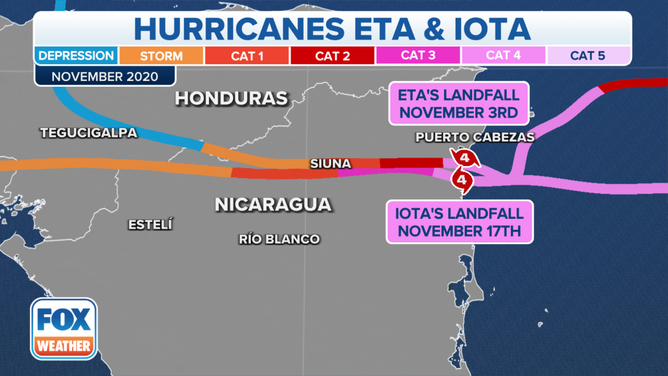
Tracks of hurricanes Eta and Iota from 2020
(FOX Weather)
According to the United Nations, more than 7.5 million people were impacted by the cyclones and disasters were declared in Guatemala, Honduras and Nicaragua.
Many of the countries have a long history of dealing with tropical trouble since the water surrounding the coasts is annually some of the warmest in the basin.
HURRICANE IAN DEATH TOLL SURPASSES 100 AS SEARCH AND RECOVERY OPERATIONS CONTINUE
Mexico
Due to the country’s location between the Atlantic basin and the Pacific Ocean, Mexico is impacted by tropical cyclones on both coasts.
Hurricanes tend to impact the country during the beginning and end of the season when steering patterns tend to prevent U.S. strikes.
The last landfall from an Atlantic basin major cyclone was Hurricane Grace in 2021.
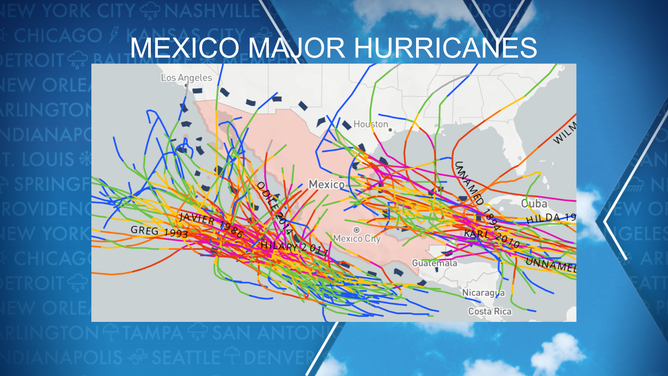
Map showing major hurricane strikes or nearby systems to Mexico
(FOX Weather)
Grace struck the mainland coast, along the Bay of Campeche, as a Category 3 hurricane, making it the strongest storm on record to make landfall in the state of Veracruz.
The NHC reported that the cyclone was responsible for over $513 million in damage and the deaths of at least 16 people.
A hurricane that holds the distinction of being one of Mexico’s strongest was Hurricane Wilma in 2005. The storm was a strong Category 4 when it made landfall along the Yucatán Peninsula.
The slow-moving hurricane remained over the area for two days, causing damage and economic losses in the billions of dollars in popular tourist destinations.
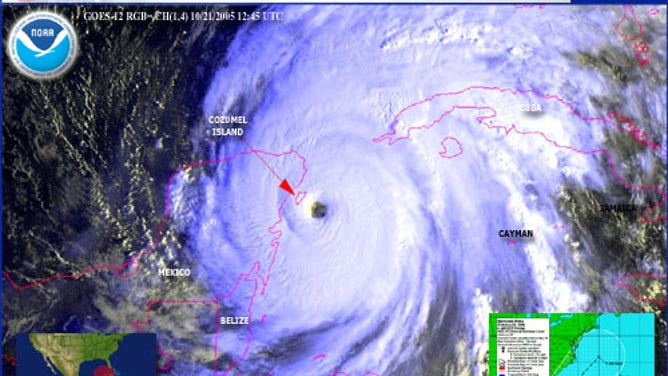
Hurricane Wilma of 2005 holds the record for being the strongest hurricane on record in the Atlantic basin.
The strongest hurricane to make landfall from the Caribbean was Hurricane Dean in 2007.
The Category 5 storm struck near the border of Mexico and Belize, an area that is less populated than tourist destinations on the Yucatán Peninsula.
Hurricane Dean was the first landfalling Category 5 cyclone anywhere in the Atlantic basin since Hurricane Andrew struck South Florida in 1992.
‘THIS IS IT’: 30-YEAR-OLD AUDIO RECOUNTS FAMILY’S FEAR AS HURRICANE ANDREW SHREDDED THEIR HOME
Belize
Due to its position along the coast of the Caribbean Sea, Belize is naturally protected from yearly impacts by hurricanes.
Over the last 133 years, the country with a population of around 500,000 has only experienced nine major hurricanes, according to NOAA data.
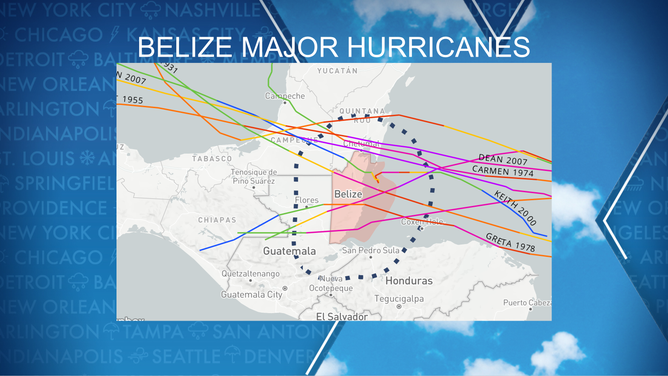
History of major hurricanes landfalling in Belize.
(FOX Weather)
The World Bank says despite the small country being tucked away from the main impact zone, the territory is highly prone to significant impacts.
The highest populated areas are low-lying, which are susceptible to flooding and storm surge.
The last hurricane to impact the country was Hurricane Nana in 2020. The Category 1 storm produced minimal damage, and no direct fatalities were reported.
SAILDRONES ADD GULF OF MEXICO TO HURRICANE HUNTING GROUNDS AFTER CAT 4 INTERCEPT IN 2021
Guatemala
Similar to Belize, Guatemala’s coastline is largely insulated from direct strikes, but remnants of hurricanes have been known to cause flooding and landslides in the mountainous country.
The UN reports Hurricane Stan of 2005 triggered more than 900 mudslides, which were responsible for many of the 1,500 deaths.
Damage in the country was estimated to be around $1 billion.

History of major hurricanes impacting Guatemala.
(FOX Weather)
Sights were similar to when the remnants of Hurricane Mitch slowly traveled over the country in 1998.
The U.S. Agency for International Development estimates the former Category 5 storm killed more than 250 people.
The U.S. Embassy estimated that 95 percent of the nation’s banana crop was destroyed, and other products such as corn, bean, coffee, and sugar crops were decimated.
FEROCIOUS FIONA LEAVES BEHIND TRAIL OF DESTRUCTION FROM CARIBBEAN TO CANADIAN MARITIMES
El Salvador
The home of around 6.5 million residents is the only country in Central America that does not have a coast along either the Gulf of Mexico or the Caribbean.
The country has about a 200-mile coastline along the Pacific, but due to the nature of where tropical cyclones develop, impacts are infrequent.
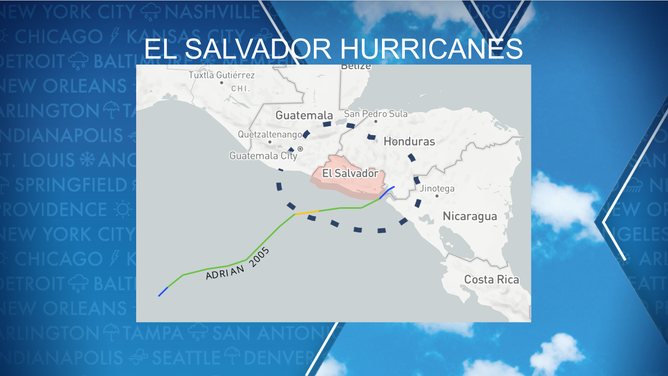
History of hurricanes impacting El Salvador
(FOX Weather)
Due to the mountainous terrain, when the remnants of a cyclone impact the country, the results can be disastrous.
The UN reports Tropical Depression 12-E in 2011 dumped nearly 5 feet of rain over a week, causing dozens of deaths and 60,000 evacuations.
Similarly, in 1998, the remnants of Hurricane Mitch caused dozens of mudslides and flooding of low-lying areas. The country reported hundreds of deaths were connected to the cyclone.
WHY DON’T TROPICAL STORMS OR HURRICANES EVER HIT CALIFORNIA?
Honduras
The country of more than 10 million people is one of the more susceptible to cyclone impacts because of the terrain and social-economic status.
The UN says Honduras is the second-poorest country in the Western hemisphere and, due to vulnerabilities, has had several large scale disasters.
Hurricane Fifi in 1974 is thought to have killed more than 8,000 and Hurricane Mitch in 1998 led to the deaths of more than 7,000.

Hurricane Mitch was a Category 5 hurricane in the Caribbean with sustained winds of 180 mph.
(NOAA)
The UN reports after Hurricane Mitch's landfall, more than 1 million residents were left homeless.
Major communities are located on hillsides, which are vulnerable to flooding and landslides.
Similar to other countries in the region, even if Nicaragua does not receive a direct landfall from a cyclone, the storm’s moisture envelope can lead to disastrous consequences.
The last significant cyclones to impact the country include the remnants of hurricanes Eta and Iota in 2020.
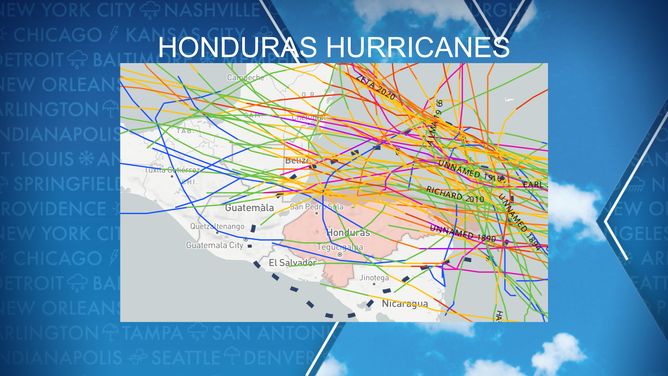
History of hurricanes impacting Honduras
(FOX Weather)
Tropical Depression Eta produced flooding for days and caused an estimated damage value of more than $1 billion.
Only weeks later, Tropical Storm Iota passed through the region leading to a combined loss of up to 80% of agriculture production, the country’s Ministry of Agriculture and Livestock said.
Nicaragua
During an average season, the country is impacted by a couple of cyclones because of how it juts out into the Caribbean Sea.
The UN reports the Global Climate Risk Index ranked Nicaragua sixth among the top ten countries that are most vulnerable to extreme weather events.
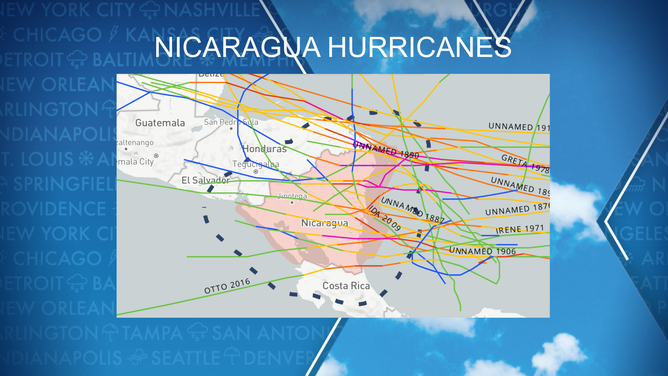
History of hurricanes impacting Nicaragua.
(FOX Weather)
Hurricanes Mitch in 1998, Beta in 2005, Felix in 2007 and hurricanes Eta and Iota in 2020 resulted in thousands of deaths.
The UN reports that large parts of the population live in overcrowded structures that are susceptible to extreme weather events.
During the 2022 hurricane season, the country was impacted by both Bonnie and Julia.
7 FACTS TO KNOW ABOUT HURRICANES
Costa Rica
Only five hurricanes in more than 130 years have either come close to or traveled over the country of 5 million people.
Due to a tropical cyclone’s vast tropical envelope, many more have impacted the country with bands of heavy rainfall.
Hurricane Nate of 2017 is considered the worst cyclone to impact Costa Rica.
The storm never made landfall in the country, but it was close enough to the circulation to see flooding rains for days.
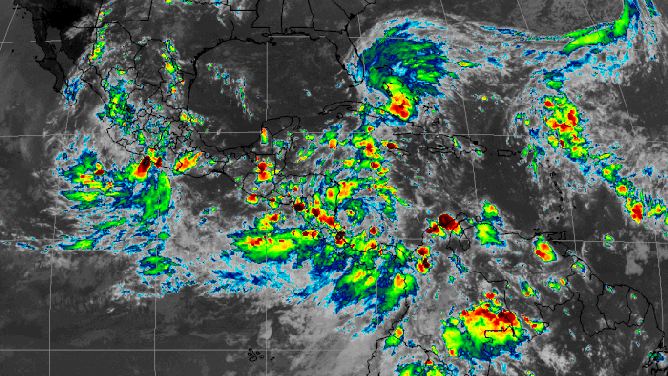
Hurricane Nate formed off the coast of Costa Rica in 2017 and was the costliest storm in the country’s history
(NOAA )
The NHC reports nearly 20 inches of rainfall fell over some communities, submerging houses and causing rivers to swell out of their banks.
Damage was estimated in 2017 to be between $500 - $600 million.
HERE’S WHY THE ATLANTIC HURRICANE SEASON RUNS FROM JUNE TO NOVEMBER
Panama
The FOX Forecast Center could not find a record of a landfalling hurricane in the country of Panama.
Hurricane Martha in 1969 was the closest to making landfall with winds greater than 73 mph, but the system quickly fell apart as it approached the coast.
The entire country is located below 10°N latitude, which is near an important benchmark for tropical cyclones.
As you approach the equator, the Coriolis force decreases, making it difficult for tropical cyclones to spin in extreme southern parts of the Caribbean Sea and Atlantic Ocean.
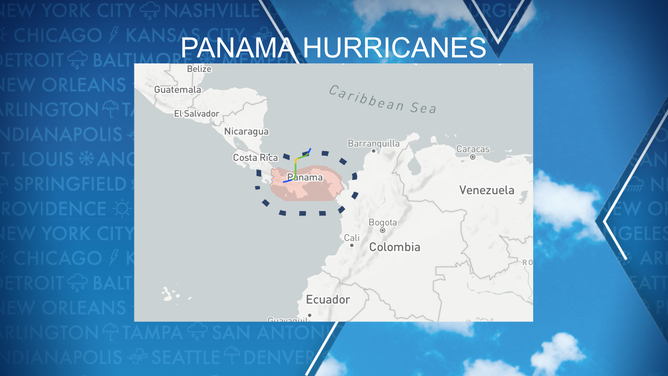
History of hurricanes impacting Panama
(FOX Weather)





